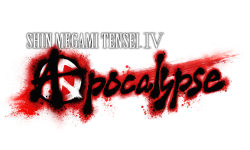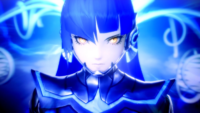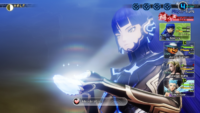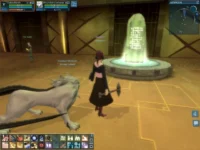The Shin Megami Tensei Series: Where to Start?
The wider Shin Megami Tensei franchise has experienced an impressive growth in popularity over the years, though it certainly didn’t start out as strongly as other RPG stalwarts. In 1987, Atlus released the first Megami Tensei game with moderate success. It did not receive the same level of acclaim the way Dragon Quest or Final Fantasy did, nor indeed the opportunity for a western release, but the Megami Tensei titles offered a much more mature angle in its storytelling and gameplay. The games borrowed elements of philosophy, religion, occultism, and science fiction, which allowed them to stand apart from other RPG franchises at the time, and arguably still do to this day.
The origins of Megami Tensei lie in Aya Nishitani’s Digital Devil Story novels, with the author being involved in the development. The first game, Digital Devil Story: Megami Tensei, came in two versions in 1987: Atlus’s entry for the Famicom featuring turn-based combat and another for PC by Telenet Japan featuring real-time combat, with the Famicom version proving most popular and setting up the base for the sequel. The gameplay drew from the popular Wizardry dungeon-crawling series, adding the element of demon summoning and negotiation.
Digital Devil Story: Megami Tensei sees two high school students accidentally unleash the power of Lucifer on the world, through a demon summon program that was created. Three years later, a sequel was released in the form of Digital Devil Story: Megami Tensei II, where this time around the game follows an unnamed man who explores the post-apocalyptic remains of Tokyo. The stories are standalone, often taking place in urban settings, with player characters having the ability to negotiate with demons and have them join their party. These recruited demons could then be used in combat. It’s important to note that at the time that the Digital Devil Story games were released, Atlus hadn’t quite begun its own publishing, partnering with Namco to release its titles.
Shin Megami Tensei, where we start this particular article, is effectively the third Megami Tensei game and was the first game Atlus could fully put under its own brand. In the years following, the series has branched out massively. It has been a gradual evolution, but gameplay and storytelling elements have evolved with each title released. What started originally as a series of first-person dungeon crawlers has now developed into a plethora of titles, with many spin-offs and sub-series developing their own unique mechanics and characteristics. The spread of titles has become so vast that for the purposes of this feature and our own sanity, we have limited ourselves to those considered part of the mainline Shin Megami Tensei series and its most direct spin-offs. We have already examined the Persona subseries, and readers can check out our guide for that, while we intend to cover additional spin-offs in a later edition.
By Sam Wachter, Kelley Ryan, Casey Pritt, Michael Baker, David McBurney, Ryan McCarthy, Cassandra Ramos, and Luis Mauricio
Shin Megami Tensei
Japan-only: Super Famicom, PC Engine CD-ROM, Mega-CD, PlayStation, Game Boy Advance, iOS* (delisted), Android, Nintendo Switch Online
* iOS version was released internationally
While the two Famicom titles were the actual start of the franchise, many fans consider the 1992 Super Famicom release of Shin Megami Tensei to be the true beginning. Like its predecessors, Shin Megami Tensei offered a distinct experience with its modern setting and first-person dungeons. Another aspect of the game that sets it apart is its tone, comparing the haunting atmosphere of the dungeons, unsettling religious imagery, and grotesque demon designs seem grim compared to the colorful RPGs from Square and Enix at the time. Unfortunately, the religious symbols and gore also meant that the game would never see an official English localization during the RPG boom of the 90s as it clashed with strict policies.
Those who have played other first-person dungeon crawlers should feel at home here. However, unless players have also experienced crushing difficulty — an aspect shared by the later Nocturne — they may have a hard time adjusting to this game’s challenge. The familiar demon negotiations are present, but these demons are significantly harder to convince. Character alignment is also a factor in demon negotiation, a factor that was later abandoned in the modern titles. While players can attempt to walk the neutral path, that path is a tightrope walk that is difficult to balance. Summoning demons in battle costs currency, which is difficult to obtain. Save points are few and far between. Dungeons seemingly go on forever, and while the game has a map system, it is cumbersome to work with. The story is minimalist at best, making players tear their hair out in frustration trying to figure out where to go next. All of these factors make the first Shin Megami Tensei a hard game to recommend for first time players. While the desire to start a series from the very beginning is strong, know that this start hasn’t found the polish the later titles in the series are known for. Shin Megami Tensei is one best suited for players who are used to the unbalanced and punishing nature of older RPGs.
Shin Megami Tensei stubbornly remains only available as an import. An iOS port of the game is its only official localization, but that came out in 2014, and the game has been delisted as it’s no longer compatible with modern phones. The good news is that amongst the import-only Shin Megami Tensei titles, this game has received the most love. The Super Famicom, original PlayStation, and Game Boy Advance versions of the game all have fully playable fan translations. The Super Famicom is the most recommended of the bunch, due to a patch that exists that makes the in-game map accessible with the shoulder buttons.
Shin Megami Tensei II
Japan-only: Super Famicom, PlayStation, Game Boy Advance, iOS, and Android
Shin Megami Tensei II is a direct follow-up taking place decades after the neutral ending of Shin Megami Tensei. Multiple natural disasters have driven humanity to a city called Tokyo Millenium built on top of the original Tokyo and cut off from the outside world with a Pyramid. While Shin Megami Tensei’s story felt bare bones and minimalist, Atlus took the time to flesh out this game’s world, giving it a unique and engaging post-apocalyptic story.
The game features the same first-person dungeon crawling, turn-based gameplay, and demon negotiations that put the series on the map. Everything feels more polished this time around, though. Combat is quicker, demon negotiations go much smoother, and the dungeons feel designed with a purpose and aren’t just random mazes. Shin Megami Tensei II let Atlus work out some of the hiccups that made the first game a chore to play. While the game is still challenging to get through, the improved battle system will help players feel like they have at least a fighting chance to make it through the game.
Even though the game is a direct sequel, players do not need to have any knowledge of the first game to enjoy the story. Everything important is explained in an opening cutscene that sets up the game’s world in a dire, hopeless tone that will send shivers up the spine. Player choices matter, affecting the paths to the ending as well as the bosses that players will fight, and the story does a better job of pointing players in the right direction this time around.
Shin Megami Tensei II does a better job of introducing the series to newcomers, both with the story, and its challenge. If players want to see the roots of the series, players can readily skip Shin Megami Tensei and jump right into this one. English options are limited, however, as only the Super Famicom version has a fan translation. Many MegaTen fans still have their fingers crossed in hopes of this game receiving an official localization, as its tone and gameplay are the perfect representation of the series as a whole.
Shin Megami Tensei III: Nocturne
Available on: PlayStation 2, PC, PlayStation 4, and Nintendo Switch
Originally released for the PlayStation 2 in Japan in 2003 before becoming the first mainline game in the series to reach North America in 2004, Shin Megami Tensei III: Nocturne is a top-notch RPG that nicely incorporates all the features that make the Megami Tensei universe so special. These including a wide set of demons to befriend, pivotal decisions to make that affect how things unfold, and a fantastic turn-based battle system. With its HD remaster released internationally in 2021 for PC, PlayStation 4, and Nintendo Switch, players can get their hands on this magnificent classic on several platforms nowadays.
Players take on the role of the Demi-fiend during a demonic war. Controlling a demon with the heart of a high school student, players explore an apocalyptic version of Tokyo called the Vortex World and decide the fate of this chaotic reality. With interesting philosophical claims putting its own stamp on a thoroughly gripping story, players decisions once again affect the ending. The visions of the perfect worlds for the diverse characters in the game causes players contemplate both their positive ideals and misguidedness at the same time. The game introduces the Press Turn combat system, which rewards fighters for exploiting enemies’ weaknesses. This battle system has become a trademark of the series and has continued to be present across spin-offs including Persona. With a wide array of demons with different skills that can be recruited and fused, combat is both challenging and fun throughout the whole journey. Exploring is also a delight with puzzles that make each dungeon feel refreshing and fun to traverse.
The mysterious setting and story are backed by an intriguing soundtrack that manages to create a unique mood for the game. The advent of this demonic revolution also looks great with the fantastic models of the demons and the Vortex World. For those who feel tempted to dive into this franchise, Shin Megami Tensei III: Nocturne is arguably one of the best starting points.
Shin Megami Tensei IV
Available on: Nintendo 3DS
Several Megami Tensei spin-offs would follow in the decade after the release of Shin Megami Tensei III: Nocturne, but the series wouldn’t see another numbered title until the release of Shin Megami Tensei IV for the Nintendo 3DS. The game begins in what seems to be a fantasy setting, the medieval Europe-like Eastern Kingdom of Mikado, a drastic departure from the mainline series. The player, given the default name Flynn, becomes a samurai, a warrior charged with protecting Mikado from the demons that infest the underground labyrinth of Naraku. It doesn’t take long for the player to travel through Naraku to encounter a more familiar srtle setting for Shin Megami Tensei as well as other returning aspects. The battle system is a refinement of the Press Turn system from Shin Megami Tensei III and other games that followed it, granting extra turns if players exploit an enemy weakness or get a critical hit. There is also the usual demon fusion, to create more powerful demons, and demon negotiation, to recruit more demons to join player. The story also traverses familiar ground, centering on the eternal war between the forces of law and chaos. Shin Megami Tensei IV also sports a substantial amount of voice acting, a first for the mainline series as well as the new Demon Whisper mechanic, which teaches Flynn a special skill that a demon knows once it learns all of its skills.
Shin Megami Tensei IV is one of the better games in the series for newcomers. The individual Shin Megami Tensei games are loosely connected at best, and Shin Megami Tensei IV is unrelated to any of the other games save for its sequel/midquel Shin Megami Tensei IV: Apocalypse. Shin Megami Tensei IV brings several user-friendly features such as being able to save anywhere, adjustable difficulty, avoiding a game over using either in-game currency or the 3DS’s Play Coins, suggestions given during demon fusion, and the ability to freely choose skills when fusing demons. It has all of the hallmarks of the Shin Megami Tensei series in terms of gameplay, themes, atmosphere, story, and characters. While the story and characters may be weaker than to other games in the franchise, the philosophical and religious overtones will be impactful to someone new to the series. The game can be difficult, even on the easiest setting, and the overworld map in later parts of the game is very confusing, making it easy to get lost. In spite of these shortcomings, Shin Megami Tensei IV is a solid game in the storied franchise and making it a good entry point for Shin Megami Tensei as a whole.
Shin Megami Tensei IV: Apocalypse
Available on: Nintendo 3DS
Shin Megami Tensei IV: Apocalypse is an interesting addition to the Shin Megami Tensei franchise. The game is a ‘what-if’ scenario that explores the results of Shin Megami Tensei IV’s Neutral Ending. With Tokyo in shambles and the protagonist of Shin Megami Tensei IV, Flynn, now regarded as a Messiah, players take on the role of Nanashi, a young hunter. Nanashi ends up making a contract with a demon named Dagda and is forced to become his servant to avoid being murdered by the demon Adramelech. Enslaved by Dagda, Nanashi and his companions must navigate Tokyo and attempt to avoid the potential Armageddon caused by Lucifer and Merkabah.
The story in Apocalypse is fantastically told, providing players with a lot of morally grey decision-making throughout. There is excellent pacing between the narrative and exploration, something Shin Megami Tensei IV struggled with. In terms of combat, Apocalypse is a useful refinement of IV’s base system, with some nice improvements made to the Press Turn and Smirk systems. Apocalypse also has a much more robust negotiation system, through the use of Nanashi’s handy dandy smartphone. One of the struggles with IV was how difficult it was to navigate Tokyo, but Apocalypse improves this detail as well. The downside is that there is also a lot of recycled content from IV from dungeons to enemy design and there isn’t a lot that feels truly new.
There are so many quality of life improvements in this game that it’s easily superior to Shin Megami Tensei IV, but the areas where Apocalypse shines, particularly in its narrative and combat improvements make it well worth exploring. Shin Megami Tensei IV: Apocalypse can work as a starting point because even though it has some roots in Shin Megami Tensei IV, it’s a game where the story truly stands on its own two feet. Players can readily get by diving straight into Apocalypse.
Shin Megami Tensei V
Available on: Nintendo Switch
Being the first mainline console entry since Nocturne, Shin Megami Tensei V was unsurprisingly met with a lot of anticipation. The story revolves around a high school student who, along with his friends, is suddenly transported to a post-apocalyptic Tokyo called Da’at that has been overrun by a battle between angels and demons. He is quickly fused with a being named Aogami to form a creature known as a Nahobino. As the Nahobino and his friends fight demons all across Da’at, they are caught in the struggle between factions over the fate of Da’at as well as their own world.
In an attempt to modernize the series, Shin Megami Tensei V mostly forgoes the traditional dungeon crawling of previous mainline entries for exploration of large outdoor areas consisting of societal ruins littered with sidequests and treasures. The Press Turn combat system makes a return with the addition of new Magatsushi skills that can be activated mid-combat during one of the player’s turns once a bar has been filled. These boosts include all hits becoming critical, temporary buffs for the entire party, and more, giving players another welcome tool to change to tide of battle. Something else new to the game is the ability to change the protagonist’s abilities as well as their elemental strengths and weaknesses by using demon essences. These elements combine with the series’ traditional gameplay to make Shin Megami Tensei V a rewarding experience for those in the mood for turn-based combat.
Whether it’s a good starting entry depends on what players are looking for. Those looking for a more traditional dungeon crawler might find the open areas lacking the feeling of a proper dungeon dive, and those wanting a narrative-focused experienced may discover the story and characters to not be particularly fleshed out or paced particularly well. However, those looking to sink their teeth with some challenging combat that keep players engaged and encourages them to stay on top of their party’s strengths and weaknesses, or those simply wanting to enjoy exploring the environment while watching the Nahobino’s hair flow like the wind, will find plenty to like here.
Shin Megami Tensei If…
Japan-only: Super Famicom, PlayStation, i-Revo PC, iOS
Shin Megami Tensei If… is one of Atlus’s first attempts at spinning off from the Shin Megami Tensei formula, and it hews closely to its Super Famicom predecessors in many ways. It’s objectively set near the beginning of Shin Megami Tensei but then takes a huge leap sideways as a disaffected high school student makes a pact with Lucifer to trade his entire school and all the souls within it for the powers of a Lord of Hell. The Hero, using one of the Devil Computers made available in the first Shin Megami Tensei, has a choice of classmates to team up with, which affects major sections in the later parts of the game. With this companion, players must explore four subsections of Hell that now connect to the high school as it floats in limbo, free classmates and faculty, and defeat zombie classmates and deranged faculty, occasionally dying in the process.
Shin Megami Tensei If… experimented with a partnered soul system, wherein demons would ride along inside the hero and their human companion, granting them powers, and the only way to upgrade was to die in battle at reasonable intervals, travel the astral to the border between life and death, and then walk away. It’s the earliest instance of what would become the basic concept of the Persona games, but it’s still got all the quirks of the earlier Shin Megami Tensei franchise to make things rough around the edges.
Players interested in the history of the series would be well advised to check this one out, if only for the experience. It’s interesting to note that this game was essentially revamped and recontextualized to become the Snow Queen’s Quest, a separate plot path in Revelations: Persona. However, if you’ve played the other Super Famicom entries of the series and decided the experience was not for you, then this one isn’t likely to be any different in that regard.
Shin Megami Tensei Nine
Japan only: Xbox
In the early 2000s, with online gaming on consoles as a growing market, Atlus decided to take a crack at making an online-enabled Shin Megami Tensei game for the Xbox. As the difficulties of actually producing an online-enabled game for the first time overwhelmed the team, the decision was made to craft a base game and then sell an online-enabled version later. Shin Megami Tensei: Nine was the result of these efforts, but its online component/update was canceled leaving this single-player, Xbox-exclusive release as its only legacy.
Nine, as a game made between the PS1 era of spin-offs and the rebirth of the mainline franchise with Nocturne, exhibits a chimeric amalgamation of traits from both along with its own odd wrinkles. The graphics, art direction, and story exhibit a bit more of the late 1990s/early 2000s cyberpunk vibe of the earlier games than the Devilman-inspired concept Nocturne would run with. Combat occurs in real time with instructions given to the protagonist and demons when players feel the need to change their behavior. The roots of the title as an online game show through with the ability to customize the appearance of the protagonist. A lot of work went into trying to bring the PS1 and Saturn era to the Xbox, but it ultimately produces a game that feels dated even for when it first released in 2002. Though it managed to drag the series away from the first-person viewpoint, the game lacks strong art direction.
Experienced series veterans might find the game a charming oddity, made as it was during a period of semi-identity crisis for the series and reflecting the pre-Press Turn style of experimental spin-offs, but it might as well have been specifically designed to be a bad place to start. It sold terribly and only released in Japan so it’s extremely expensive on the secondary market. The game was never ported and is thus only playable on a Japanese Xbox. No fan translations exist outside a text document that partially translates the script. It’s dialog heavy and the Japanese isn’t exactly beginner-friendly, while the unique mechanics make it ill-suited to just using information about other games in the series to muddle through. In almost every way it is possible for a game to be a poor starting option, Shin Megami Tensei: Nine checks the boxes.
Shin Megami Tensei IMAGINE
Formerly available on: PC
MegaTen‘s only “successful” foray into the MMORPG genre, Shin Megami Tensei IMAGINE, made its Japanese debut in 2007, with North American and European servers opening in 2008 and 2009, respectively. However, this title would not enjoy a full decade of live service; western servers shuttered in early 2014, and Japanese ones followed suit in 2016. Although no longer a valid series starting point for gamers in many parts of the world, IMAGINE has left behind a unique legacy that cements its place in RPG history.
As part of its MMORPG trappings, IMAGINE’s character creation boasted a respectable number of options for its time. After designing their own Demon Buster avatar, players would enter a persistent world where they could ally with demons and fight in real-time battles, solo or alongside other players. By successfully melding series staples — including negotiation, fusion, an alignment system, and a robust story — with fresh features such as stance-switching combat and a mix-and-match class system, the game distinguished itself from its MMO contemporaries. As a free-to-play game, it also operated a cash shop, where players could spend real money on a variety of cosmetics, convenience items, and even strong equipment, but it appears that the best gear was only available through gameplay. Even players who chose to spend nary a dime in the cash shop could obtain premium items through trade with other players.
Like any respectable MegaTen game, IMAGINE could be fiendishly difficult at times. While one might envision this breeding toxicity, the player base was noted as by and large being very kind and helpful. Whether in the form of building an extensive wiki or going out of their way to resurrect a fallen fellow player, members of the community wanted to make their game a more enjoyable experience for all involved. Following the closure of IMAGINE’s official version, fans even hosted their own private servers for a time. Unfortunately, these servers have gone dark since running into legal trouble with Atlus.
Shin Megami Tensei: Strange Journey
Available on: Nintendo DS and Nintendo 3DS
Shin Megami Tensei: Strange Journey, is the perfect modern representation of classic Shin Megami Tensei gameplay. Released in 2009, this title was originally conceived as Shin Megami Tensei IV before the development team decided it wanted the numbered title to go in a different direction. Buoyed by the success of the Etrian Odyssey series on the Nintendo DS, Atlus used Strange Journey to bring the series back to its first-person roots, as well as create a large-scale roleplaying game for a portable console.
The story takes place in Antarctica during the 21st century asa massive black hole called the Schwarzwelt threatens to envelop the earth into darkness. Players take on the role of a soldier in a task force assigned to investigate the Schwarzwelt in hopes of finding its purpose and possibly destroying it. As the player ventures deeper into the labyrinth of the black hole, much more of the story plays out, involving other soldiers in the task force, Gods, Demons, and an ever-learning AI. Other works of fiction, such as The Thing, Aliens, Damnation Alley, and At the Mountains of Madness are cited as inspirations for this game’s ominous story, giving science-fiction-loving RPGamers something satisfying to chew on.
This game offers longtime fans of the series a challenge they won’t forget. However, its modern sensibilities make the game far more approachable than the earlier entries. A detailed map on the bottom screen guides the player through the Schwarzwelt, but doesn’t hold their hand either. Players can endlessly experiment with the game’s robust demon fusion system, giving them the skills they need to conquer the Schwarzwelt. This game is the perhaps most approachable Shin Megami Tensei game to beginners, as it eases players into the challenge of the series instead of dunking them head first.
If that wasn’t enough, Atlus released an enhanced port of the game in 2017 for the 3DS, Shin Megami Tensei: Strange Journey Redux. In addition to adding voice acting, new demons, and enhanced maps to the game, it also features an additional, optional dungeon, called the Womb of Woe, that offers a wealth of new content for fans of the original DS’s Strange Journey and makes the Redux version a strong recommendation for newcomers. A specific quest from the Womb of Woe rewards an item that lets players turn off low-level enemy encounters, removing much of the tedium when exploring previous sectors. This makes Strange Journey Redux is the certainly definitive version of the game, and almost a must-have for any player wanting to get into Shin Megami Tensei.
The Shin Megami Tensei series has quite the history, and we hope you enjoyed part one of our deep dive into this long-running franchise. Would you recommend a specific starting point? Join the conversation by dropping a comment below!


































As a scrub who has only played IV Apocalypse and V, which I both really enjoyed (edge goes to IV:A), this makes me want to give Strange Journey a go. My 3DS isn’t going to be retired for years yet…